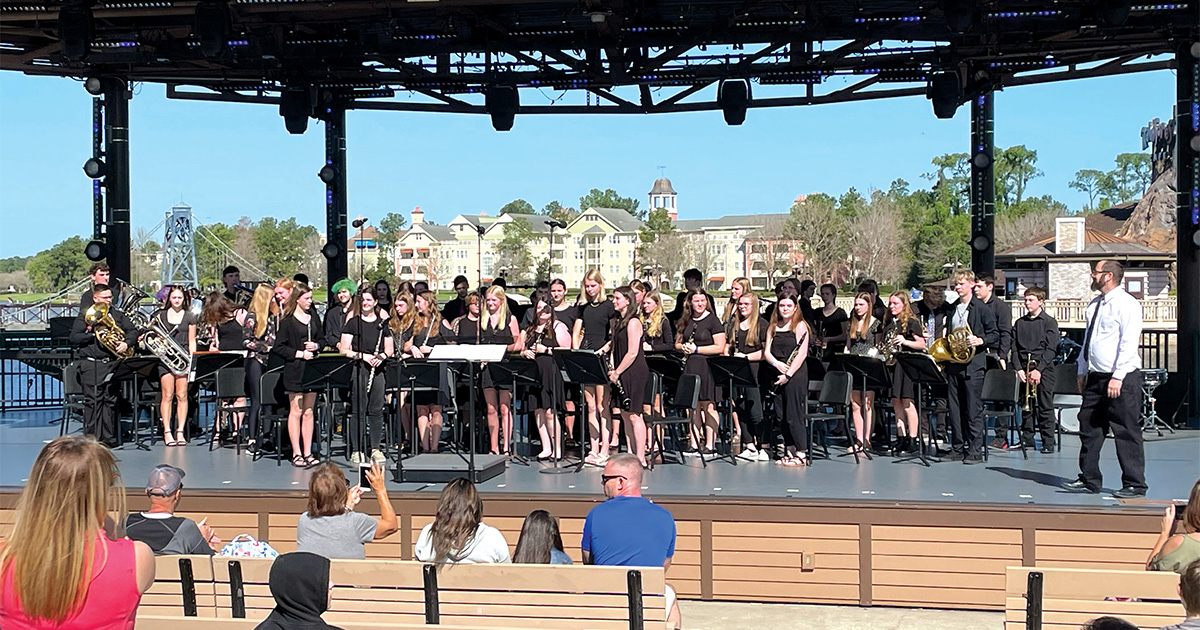Note: This story from Julie Beck was originally written for a 2013 Trip Behavior column in Teach & Travel.
One of my college students, Jessica, recently sent me an e-mail that showed a picture of a school bus filled with students on a field trip. I found myself laughing at the image of this bus with three key phrases. At the front, it was labeled “Quiet ones.” In the middle, it read “Normal ones.” At the back of the bus, it showed the “Naughty & Noisy ones.”
The photograph resonated with me because it reminded me of a middle school field trip to Columbus, Ohio. My father, the seventh-grade history teacher, was taking the entire class to visit our capital city. He made the seating assignments and while we sat at the dining room table one evening, he shared who would be riding on what bus. I realized my friends and I were scheduled to ride on three different buses, so I convinced him to redo the bus assignments. Of course, I listed my friends and all of the cute boys we liked on the same bus. The classmates we deemed to be rowdy and party animals were destined to be on the second bus, while those shy, reserved students were placed on the last bus.
I can’t speak about what happened on the other two buses, but on the four-hour ride home from Columbus, the students on my bus had fun. We played “Truth or Dare.” You remember this game, where you have to choose “truth” or “dare.” If you say “truth,” you have to answer, with honesty, the question that was posed to you. If you say “dare,” there is no telling what you might have to do. There was a cute boy, Jim, who I really liked, and he agreed to take a dare. My friend knew I liked him, so she told him that he had to kiss me. My heart beat rapidly in anticipation. This was my first real kiss, even though it was just a quick peck on the lips. My friends had to do some wild and crazy stuff—like pulling up her shirt and flashing someone briefly, telling a “geek” on the bus that she thought he was sexy, and letting a guy briefly touch her breast. We were a bit wild on the bus, but not out of control.
My story is symbolic of things that could happen in the back of the bus. However, I truly believe that what we did then was mild compared to what could and does occur now on school field trips. As a teacher who is leading a trip, you are responsible for the students’ behavior at all times, including transportation to and from a location and within a destination city. What could you do to prevent and react to these situations that take place among the quiet, the normal, and yes, the naughty and noisy ones?
I tutor GED students, ages eighteen to twenty-five, so I quizzed them about what kind of escapades students engage in on a bus. Here is what they shared with me. First and foremost, students will engage in some type of sexual activity, whether it’s kissing, heavy petting, or even “hooking up.” Hormones are running high and students will act on them, openly or discretely. As a chaperone, you must remind students to dress appropriately to reduce the temptation. If they don’t adhere to the dress code, don’t allow them to board the bus. Remind students to keep their clothes on (sounds like a dumb statement, but it lets the students know your expectations), and separate the boys and girls by letting the boys sit on one side of the bus while the girls are on the other. Or, put one sex in front and the other in the back of the bus. Also, make sure there are several chaperones, spaced throughout the bus to oversee the students’ behavior. If you notice inappropriate behavior between or among students, separate the rule violators and have them switch seats. You could also be blunt and ask, “Is this appropriate behavior? What would your mother think if she saw you doing this?” This will get the students thinking about their behavior.
The second offense they mentioned included the use of alcohol, drugs, cigarettes, and chewing tobacco. According to the GED students, high school students will inevitably sneak a flask, joint, pack of cigarettes, or tin of chewing tobacco into their bags. Prior to departure, remind students that the use of alcohol, drugs, and chewing tobacco will not be tolerated. Rules for when students could smoke, if at all, shall be established up front. Plus, remind them that their usage is illegal. If they are caught with any illegal substances in their possession, they will be disciplined and may possibly be reported to the law. Chaperones may have to search bags before boarding the bus. The students may still sneak alcohol and drugs, but if they know the consequences in advance, they may be intimidated about obtaining and using these illegal substances on a school trip.
A third illicit behavior may include students acting inappropriately to passing vehicles. Students may drop their pants and show a “full moon”, “flip the bird” (give someone the middle finger), flash body parts, or hold up inappropriate signs to others. This is why it is important to place chaperones throughout the bus to monitor the behavior of the students. Students who do not adhere to the rules shall be disciplined appropriately.
Finally, my students shared that access to technology, via cellphones and iPads, may cause problems on the bus. Chaperones aren’t always aware of what students are reviewing on these electronic gadgets. Easy accessibility to the Web and social media sites could lead to students viewing inappropriate materials. This is a bit harder to enforce, unless you take cellphones and iPads from the students. I could elaborate on this topic, but that could be the focus of a whole-trip behavior column—so I will just say that teachers and chaperones must stress to students their being responsible when using technology, particularly on school trips.
In addition to the prevention techniques already mentioned, teachers could engage the students in activities (educational worksheets and social games), place cameras on the buses to monitor behavior, and periodically provide snacks. Do anything to keep the students busy and out of trouble. If and when bad behavior occurs, however, it must be dealt with immediately. If needed, ask the bus driver to pull over, and then handle the situation. If the bus has not ventured too far from home, the parent(s) could be contacted and the student(s) could be removed from the bus. Key elements of a successful school field trip on a bus are for the chaperone to set high expectations, enforce the rules, constantly remind students of appropriate behavior, and keep safety in mind, no matter the scenario. Then and only then will everyone have a safe, enjoyable, fun, and educational trip.
Since I’ve broken the rules in the past and know what to look for when traveling with teenagers, I don’t mind chaperoning school trips. After listening to my GED students highlight the hormonal activities as well as the alcohol and drug usage that could and does occur in the back of the bus on school field trips, I realize that my friends and I (back in the seventh grade) were the just the “normal ones.” Yes, maybe we were a bit “naughty.” But we remained “quiet” in our activities so we wouldn’t (and didn’t) get caught.
Of course, as soon as my father reads this article, I’m going to have a lot of explaining to do.




